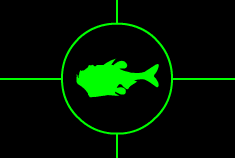
Deep Sea Hatchetfish
Other Names: None
Scientific Name: Argyropelecus gigas
Size Range: About 4 inches
Habitat: World wide
Depth Range: 600 - 4,500 feet
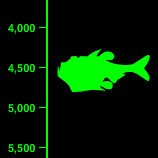
Deep Sea Hatchetfish
(Argyropelecus gigas)
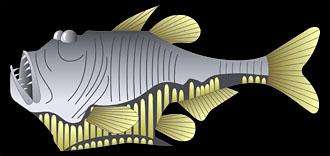 The deep sea hatchetfish gets its name from the distinct hatchet-like shape of its body. It is a member of the Sternoptychidae family of deep sea fishes. There are about 45 individual species of hatchetfish that vary in size from one to six inches. They are most well known for their extremely thin bodies which really do resemble the blade of a hatchet. They should not be confused with the freshwater hatchetfish commonly seen in home aquariums.
The deep sea hatchetfish gets its name from the distinct hatchet-like shape of its body. It is a member of the Sternoptychidae family of deep sea fishes. There are about 45 individual species of hatchetfish that vary in size from one to six inches. They are most well known for their extremely thin bodies which really do resemble the blade of a hatchet. They should not be confused with the freshwater hatchetfish commonly seen in home aquariums.
Of the several species of hatchetfish that inhabit the ocean depths, the largest is Argyropelecus gigas, also known as the giant or large hatchetfish. This giant of the family grows to an impressive six inches (12 centimeters) in length. Most of the smaller hatchetfish species are covered in delicate silvery scales. Some species, including the giant hatchetfish can be brown or dark green in color. Hatchetfishes have large, tubular eyes that pointing upward. This enables them to search for food falling from the above. Because there is very little light at the great depths at which they are found, their eyes have become extremely sensitive to light and are good at distinguishing shadows against the extremely faint illumination from above.
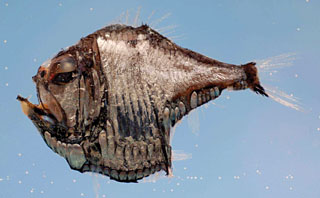
Deep Sea Hatchetfish specimen
(NOAA Public Domain Image)
Hatchetfishes are one of the many deep sea creatures that have the ability to create their own light through a process known as bioluminescence. These fish have special light-producing organs known as photophores that run along the length of their body. These photophores produce light by means of a chemical reaction similar to that of the land-based firefly. Since these light organs point downward, it is believed they are used to hide the fish from predators through the process of counterillumination. This means that they can adjust the intensity of their underside lights to make them nearly invisible against the faint light above. The patterns of light created by the photophores differs slightly from one species to another, leading many researchers to believe that they may play a role in courtship, although very little is know about the mating habits of these mysterious creatures.
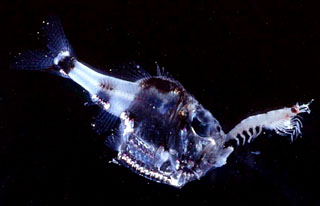
Image of a hatchetfish feeding on a shrimp
(© Edd48 / CC BY-SA 3.0)
Not much is known about the life cycle of hatchetfishes. Most researchers agree that they have a short life span of no longer than a year. It is believed that they migrate to shallower waters at night to feed mainly on plankton and tiny fish. They hunt by looking for the silhouettes of their prey moving overhead. At day break, they return to the blackness of the deep ocean. Most of their reproductive habits are a mystery, although it is known that the juveniles look much different that the adults. Hatchetfishes are found in most temperate waters of the world where they are found at depths ranging from 600 feet (180 meters) to 4,500 feet (1,370 meters).
Deep Sea
Creature Database
'



